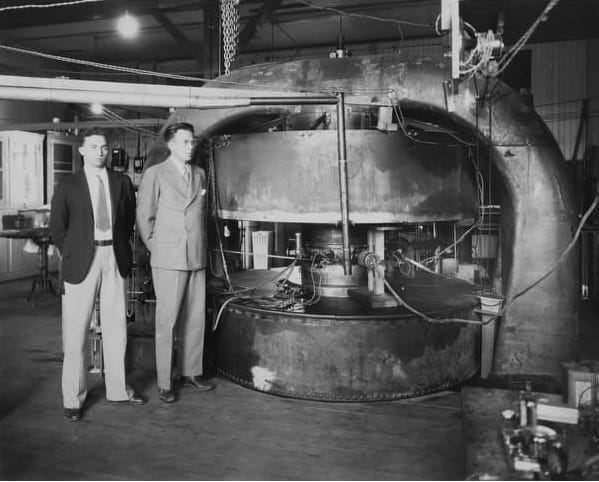A cyclotron is a type of particle accelerator invented by Ernest O. Lawrence in 1934 in which charged particles accelerate outwards from the centre along a spiral path. The particles are held to a spiral trajectory by a static magnetic field and accelerated by a rapidly varying (radio frequency) electric field. Wikipedia, Cyclotron
The cyclotron was invented and patented US1948384A, application filed January 26, 1932, patent granted on February 20, 1934 by Dr. Ernest O. Lawrence, winner of the Nobel Prize in Physics in 1939 "for the invention and development of the cyclotron and for results obtained with it, especially with regard to artificial radioactive elements." One of the tasks the larger cyclotrons would perform during World War II was the electromagnetic separation of the fissionable U235 (Uranium 235 isotope) from the non-fissionable U238 [other approaches used in *parallel* were gaseous diffusion and high-speed centrifuge].
Image: The enclosed is an improvement over the original image contained in the Nobel Lecture delivered by Ernest O. Lawrence entitled "The evolution of the cyclotron." The Nobel Lecture article contains the following statement for the image: "General view of 27” cyclotron built by young physicists including M.S. Livingston (left) and E. O. Lawrence (right). (The lack of good engineering design is quite evident!)"
World's First Particle Accelerator
The world’s first particle accelerator, the cyclotron, was invented by Ernest O. Lawrence in 1929–1930 at the University of California, Berkeley, and patented in 1932. A cyclotron accelerates charged particles outwards from the center of a flat cylindrical vacuum chamber along a spiral path. The particles are held to a spiral trajectory by a static magnetic field and accelerated by a rapidly varying electric field. Lawrence was awarded the 1939 Nobel Prize in Physics for this invention.
The cyclotron was the first “cyclical” accelerator, meaning that it could accelerate particles many times by making them follow a circular or spiral path. The energy gained by the particles was limited by the maximum electrical potential that could be achieved across the accelerating region. This potential was in turn limited by electrostatic breakdown to a few million volts. In a cyclotron, by contrast, the particles encounter the accelerating region many times by following a spiral path, so the output energy can be many times the energy gained in a single accelerating step.
The cyclotron was the most powerful particle accelerator technology until the 1950s, when it was superseded by the synchrotron. Despite no longer being the highest-energy accelerator, they are still widely used to produce particle beams for nuclear medicine and basic research. As of 2020, close to 1500 cyclotrons were in use worldwide for the production of radionuclides for nuclear medicine. In addition, cyclotrons can be used for particle therapy, where particle beams are directly applied to patients.

Schauberger
The outbirth of this ur-fertilisation is the physically first-born. It is the geospherically negatively supercharged amniotic fluid of the Earth in which, as is the case with all physical forms of procreation, the co-originating spirit is bound, which is also ur-created through the above higher-grade processes of motion and excitation. In the opposite case the most dangerous dynagen concentrate results, which only recently, free of any constraint, is being generated with the aid of an ingeniously designed centrifuge - the cyclotron - for the supposed purposes of national defence. [The Energy Evolution - Harnessing Free Energy from Nature, Cadaverine Poison in Ray-Form - Ptomaine Radiation]
See Also
